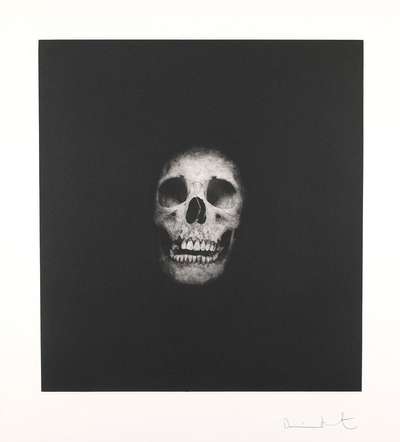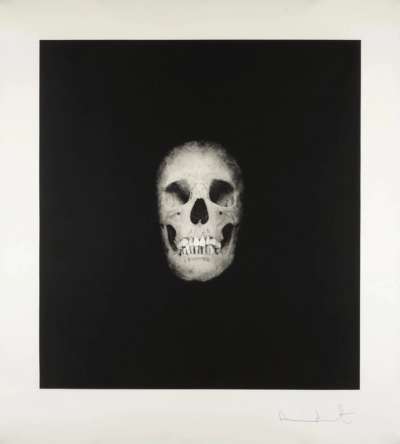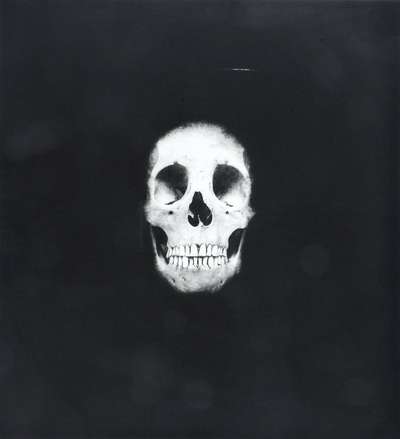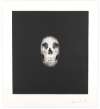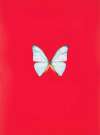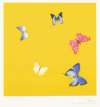I Once Was What You Are, You Will Be What I Am
The title of Damien Hirst's 2007 print series, 'I Once Was What You Are, You Will Be What I Am Now', translates a common Latin epitaph, signalling clearly the prints' memento mori theme. Each of six prints depicts a different white skull, contrast dramatically against a blackened backdrop.
Damien Hirst I Once Was What You Are, You Will Be What I Am For sale
I Once Was What You Are, You Will Be What I Am Value (5 Years)
Damien Hirst's I Once Was What You Are, You Will Be What I Am series has historically shown more modest results compared with the artist’s wider oeuvre, with auction prices ranging from £750 to £5729. Average annual growth has remained modest at -1.43%, with certain works seeing declines in value. Over 19 total auction appearances, average selling prices have held steady around £3378. This series appeals to collectors seeking accessible entry points into Damien Hirst’s print market.
I Once Was What You Are, You Will Be What I Am Market value
Auction Results
| Artwork | Auction Date | Auction House | Return to Seller | Hammer Price | Buyer Paid |
|---|---|---|---|---|---|
 I Once Was What You Are, You Will Be What I Am 2 Damien Hirst Signed Print | 26 Oct 2020 | Chiswick Auctions | £2,083 | £2,450 | £3,250 |
 I Once Was What You Are, You Will Be What I Am 1 Damien Hirst Signed Print | 31 Jul 2019 | John Nicholson's | £638 | £750 | £950 |
 I Once Was What You Are, You Will Be What I Am 3 Damien Hirst Signed Print | 26 Aug 2015 | Deutscher & Hackett, Melbourne | £4,080 | £4,800 | £6,000 |
 I Once Was What You Are, You Will Be What I Am 4 Damien Hirst Signed Print | 19 Sept 2012 | Christie's London | £2,380 | £2,800 | £3,750 |
 I Once Was What You Are, You Will Be What I Am 5 Damien Hirst Signed Print | 30 Mar 2010 | Sotheby's Online | £4,250 | £5,000 | £7,000 |
Sell Your Art
with Us
with Us
Join Our Network of Collectors. Buy, Sell and Track Demand
Meaning & Analysis
I Once Was What You Are,You Will Be What I Am Now’ is a direct translation of the Latin epitaph: ‘Quod tu es, ego fui, quod ego sum, tu eris’. Hirst uses these words to title each of the six signed photogravure etchings in this series, and as a title for the series as a whole. Produced in 2007 in an edition of 48 these artworks are all signed and numbered by the artist.
Each of the six artworks depicts a different white skull, leering out from a blackened backdrop. The skull has become an icon for death, a universally recognisable symbol that transcends culture and history: the skull and crossbones on a bottle of poison or the Jolly Roger emblazoned on a pirate flag. The skull as memento mori is a symbol found throughout Hirst’s body of work, and the exploration of life, death and immortality is central to many of the artist’s most important artworks.
In 2007 Hirst also produced For the Love of God, a replica skull set with over eight thousand diamonds. Of death he has said ‘You don’t like it, so you disguise it or you decorate it to make it look like something bearable - to such an extent that it becomes something else’. This ‘decoration’ of death can of course be found in For the Love of God and also in this series. The skull is a potent reminder of the inevitable, but also something to be appreciated on a visual level.
In isolation the skulls pictured in this series can be taken as a symbol, but in their group the differences between individual skulls becomes apparent; a gap between teeth or an offset jaw suddenly becomes the makings of individuality, even personality. These skulls become more than icons but representatives of their former selves, heightening their message: ‘I once was what you are, you will be what I am’.
